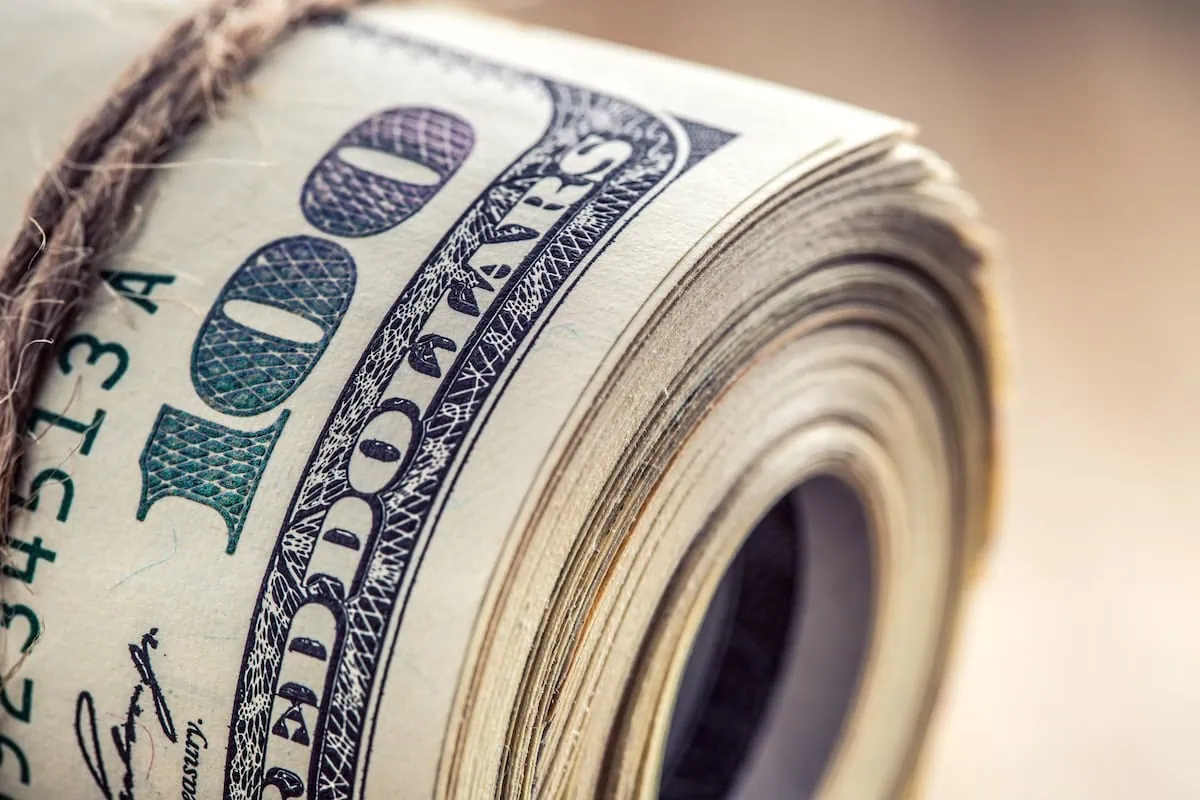Who will be the extra lucky winner of the $1.15 billion Mega Millions Jackpot? The odds of winning the jackpot are 1 in 302.6 million (slightly lower than the 1 in 292.2 million odds for winning the Powerball jackpot).
Once the winner gets picked, they’ll have a decision to make—claim the $1.15 billion in 30 annual annuity payments or take a one-time, lump-sum cash payment of approximately $516.1 million.
Regardless of the choice made, the winner will see a significant reduction in their windfall once taxes are settled. Both the federal government and the state will claim their portions, leaving the winner with less than the initial jackpot.
What’s the tax bill for snagging a $1.15 billion Mega Millions jackpot, and what amount will the winner actually get to enjoy? Read on to find out.
Featured Financial Products
Table of Contents
Federal Taxes on Mega Millions Winnings

Let’s start with some basics on how the federal government taxes Mega Millions winnings, which are considered taxable income.
Federal Tax Rates

First, you should know that the current federal income tax rates run from 10% to 37%. So, depending on the amount of prize money received, the federal tax on lottery winnings can be relatively low or quite high.
If we focus on large lottery prizes (like Friday’s $1.15 billion Mega Millions jackpot), you can see how easily the highest federal tax rate comes into play. For the 2024 tax year, the top federal tax rate (37%) kicks in if your taxable income exceeds $609,350 and you’re single. If you’re married and file a joint tax return, then the top tax rate applies to taxable income over $731,200. As a result, lottery prizes above the applicable threshold amount will be taxed at the top federal tax rate.
Note, however, that most tax rates are scheduled to rise in 2026 (unless Congress steps in to keep them at the current rate). The top tax rate will jump to 39.6% at that time. This will impact lottery winners who receive payments over a 30-year period, because they’ll have to pay taxes on payments received after 2025 at the higher rate.
Do you want to get serious about saving and planning for retirement? Sign up for Retire With Riley, Young and the Invested’s free retirement planning newsletter.
State Tax Rates

State tax rates might also come into play when determining how much tax a lottery winner must pay. While not all states have state income taxes, generally speaking, most states do and the lottery winnings will almost certainly fall into the top tax bracket for the winner’s state.
Rates can vary state-to-state, but most fall in the lower single-digit to lower double digit range, adding an additional amount of tax the lottery winner needs to pay on any winnings.
Related: 13 Best Mutual Funds to Buy
Tax Withholding

It’s also important to realize that, if you win a lottery prize of at least $5,000, 24% of your lottery winnings will be withheld from your payment for taxes and sent to the IRS. This will be applied toward your overall tax bill when you file your federal tax return for the year, so it’s not an additional tax. It’s more like paying part of the tax you’ll ultimately owe in advance.
Related: 7 Best High-Quality, High-Yield Dividend Stocks to Buy (Yields Up to 9%)
For example, with a $1 million prize, $240,000 ($1 million x .24) would be subtracted from you payout immediately (i.e., you would only receive a $760,000 payment). However, when you file your tax return for the year, you would claim a credit for the amount withheld and $240,000 would be subtracted from your overall tax bill.
There might be additional requirements depending on the state or locality you live in as well. The above only applies to federal income tax withholdings.
Related: 10 Best Fidelity Funds to Buy
Featured Financial Products
Form W-2G

If you win and collect at least $600 from a lottery in 2024, expect a Form W-2G in the mail by January 31, 2025. The form will list your lottery winnings, federal and state taxes withheld, and other information required by the IRS.
The IRS will also receive a copy of the form. So, make sure you report the proper amount when you file your tax return for any year you receive a lottery payment. If you don’t, the IRS will want to know why the amounts on the W-2G and your tax return don’t match … and you really don’t want to draw the IRS’s attention to your return.
Related: 9 Best Fidelity Index Funds to Buy
Filing Your Tax Return

When it’s time to file your federal return, you’ll report any lottery winnings as gambling income on Line 8b of Schedule 1 (Form 1040). [The form or line number could change for 2024 tax returns.]
If you have gambling income, that means you can also deduct any gambling losses for the year … but only up to the amount of gambling income reported on your return. You also have to itemize to deduct gambling losses, which means you can’t claim the standard deduction on your return. As a result, depending on your standard deduction amount, you might be better off skipping the gambling loss deduction.
Related: These 7 Funds Yield Up to 11% (And Hardly Anyone Knows About Them)
Federal and State Taxes On the $1.15 Billion Mega Millions Jackpot (Dec. 27, 2024)

Now let’s focus on Friday’s Mega Millions drawing for an estimated $1.15 billion jackpot. If you’re the lucky winner, approximately how much spending money would be left after taxes are paid to the federal government? Let’s do some math.
Related: Best Fidelity Retirement Funds for a 401(k) Plan
Lump-Sum Payout

Most lottery winners opt for a lump-sum amount. If the winner claims the lump-sum, he or she will pay approximately $190.9 million in federal taxes on the lump-sum prize of $516.1 million. About $123.9 million (24%), will be withheld from the payment up front, so the winner will have to pay the rest of the $190.9 million when he or she files a 2024 federal income tax return next year.
Related: 10 Best Vanguard Funds to Buy for the Everyday Investor
If $190.9 million is subtracted from the $516.1 million lump-sum payment, that leaves about $325.2 million to spend. While that doesn’t sound as nice as $516.1 million, it’s not too shabby for a $2 gamble.
Annuity Option

If the winner selects the annuity option, he or she will receive an initial annuity payment when the prize is claimed, followed by 29 annual payments that increase by 5% each year (i.e., a total of 30 annual payments). Assuming the winner is single and receives the first payment in 2024 (approximately $17.3 million), the total federal income tax bill for the first two payments (2024 and 2025) will be based on the current 37% tax rate—for a total of about $13.0 million in tax for that period. (That assumes a 2.5% increase in the tax bracket thresholds from 2024 to 2025.)
Related: 7 Best Schwab Funds to Buy
Once the rate jumps to 39.6% in 2026 (and assuming it isn’t changed again later), the estimated total federal income tax for the final 28 years (2026 to 2053) comes to about $438.9 million. So, for all 30 years, the winner can expect to pay a grand total of about $452.0 million in federal income taxes.
When you subtract that amount from the $1.15 billion in total payments, the winner will be left with approximately $698.0 million at the federal level.
Related: 10 Best Vanguard Index Funds to Buy
Featured Financial Products
Which Payment Option Is Better?

After seeing the after-tax amounts above, you might be wondering why most people choose to receive their lottery winnings in a lump-sum. After all, isn’t getting $1.15 billion better than $516.1 million?
Related: 7 Best T. Rowe Price Funds to Buy
Not necessarily. The problem with annuity payments is that you have to wait 30 years to get all your money. With the lump-sum option, you get less … but you get it right away. If you invest that money wisely over a 30-year period, you’ll probably end up with far more money in the bank when all is said and done. For example, after 30 years, a $516.1 million investment would turn into approximately $2,305.8 million ($2.3 billion) with a modest 5% rate of return (compounded monthly).
Related: 9 Monthly Dividend Stocks For Regular, Frequent Income
Young and the Invested Tip: All tax amounts are estimates based on the listed jackpot amounts. They should not be relied on or considered tax advice. If you do win the lottery, consult with a qualified tax professional right away!
Do you want to get serious about saving and planning for retirement? Sign up for Retire With Riley, Young and the Invested’s free retirement planning newsletter.
Related: 7 Best High-Quality, High-Yield Dividend Stocks to Buy

Looking to earn some serious dividend income? These high-quality, high-yield dividend stocks are well-regarded not only for their high payouts, but for the sustainability of those dividends (at least in the eyes of investment professionals covering the stocks).
We look into these seven companies’ dividend profiles and why analysts think their stocks are well worth holding in your income portfolio.
Related: 6 Best Stock Recommendation Services [Stock Picking + Tips]

Stock recommendation services are popular shortcuts that help millions of investors make educated decisions without having to spend hours of time doing research. But just like, say, a driving shortcut, the quality of stock recommendations can vary widely—and who you’re willing to listen to largely boils down to track record and trust.
The natural question, then, is “Which services are worth a shot?” We explore some of the best (and best-known) stock recommendation services.
Related: 12 Best Long-Term Stocks to Buy and Hold Forever
As even novice investors probably know, funds—whether they’re mutual funds or exchange-traded funds (ETFs)—are the simplest and easiest ways to invest in the stock market. But the best long-term stocks also offer many investors a way to stay “invested” intellectually—by following companies they believe in. They also provide investors with the potential for outperformance.
So if you’re looking for a starting point for your own portfolio, look no further. Check out our list of the best long-term stocks for buy-and-hold investors.
Related: 9 Best Monthly Dividend Stocks for Frequent, Regular Income

The vast majority of American dividend stocks pay regular, reliable payouts—and they do so at a more frequent clip (quarterly) than dividend stocks in most other countries (typically every six months or year).
Still, if you’ve ever thought to yourself, “it’d sure be nice to collect these dividends more often,” you don’t have to look far. While they’re not terribly common, American exchanges boast dozens of monthly dividend stocks.
Please Don’t Forget to Like, Follow and Comment

Did you find this article helpful? We’d love to hear your thoughts! Leave a comment with the box on the left-hand side of the screen and share your thoughts.
Also, do you want to stay up-to-date on our latest content?
1. Follow us by clicking the [+ Follow] button above,
2. Subscribe to Retire With Riley, our free weekly retirement planning newsletter, and
3. Give the article a Thumbs Up on the top-left side of the screen.
4. And lastly, if you think this information would benefit your friends and family, don’t hesitate to share it with them!





![IRA Contribution Limits for 2025 [Retirement Savings Cap] 33 ira contribution limits for 2024](https://wealthup.com/wp-content/uploads/ira-contribution-limits-for-2024-600x403.webp)
![401(k) Contribution Limits for 2025 [Save More Next Year] 34 401k contribution limits for 2024 are higher](https://wealthup.com/wp-content/uploads/401k-contribution-limits-for-2024-are-higher-600x403.webp)
